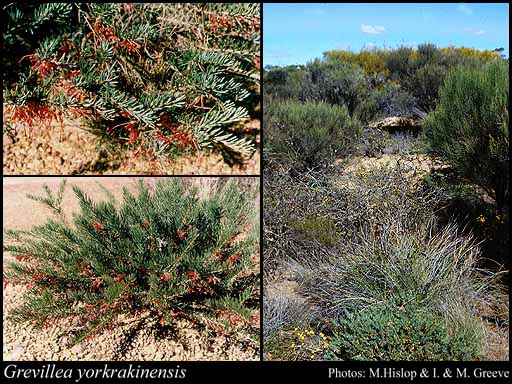- Reference
- J.& Proc.Roy.Soc.Western Australia 9:34 (1923)
- Conservation Code
- Not threatened
- Naturalised Status
- Native to Western Australia
- Name Status
- Current
Low, usually dense & spreading shrub, 0.15-0.5 m high, up to 0.6 m wide. Fl. red/red-orange-yellow, May to Oct. Yellow sand, sandy loam, sandy clay (sometimes with gravel). Sandplains, often on or near granite exposures.

Scientific Description
Shrubs, 0.20-0.40 m high; branchlets hairy, not glaucous. Leaves alternate, 5-15 mm long, 0.6-1.2 mm wide, hairy, on the adaxial or abaxial surface, the hairs straight; lamina flat, more or less the same width throughout, entire, the margins revolute, enclosing the lower surface of the leaf blade, forming a groove either side of the midvein. Inflorescences axillary or cauline, orange or red; pedicels 3-4 mm long. Perianth 7-10 mm long; tepals some joined and some free after flower opens, hairy, simple-hairy; ovary hairy, stipitate, the stipe 0.5-1 mm long; pistil 18-22 mm long, green or pink, pollen presenter lateral, style hairy. Follicles hairy, not viscid, dehiscent, 7-10.5 mm long. Flowers in May, June, July, August, September or October. Occurs in the Eremaean (ER) or South-west (SW) Botanical Province(s), in the Yalgoo (YAL), Coolgardie (COO), Avon Wheatbelt (AW) or Mallee (MAL) IBRA subregion(s).
Distribution
- IBRA Regions
- Avon Wheatbelt, Coolgardie, Mallee, Yalgoo.
- IBRA Subregions
- Merredin, Southern Cross, Tallering, Western Mallee.
- Local Government Areas (LGAs)
- Bruce Rock, Coolgardie, Dalwallinu, Kondinin, Koorda, Lake Grace, Merredin, Mount Marshall, Mukinbudin, Narembeen, Perenjori, Tammin, Trayning, Westonia, Yalgoo, Yilgarn.